Tolten (2/2)
Chapter 36: Tolten
reprinted from Shipwrecks of New Jersey: Central by Gary Gentile
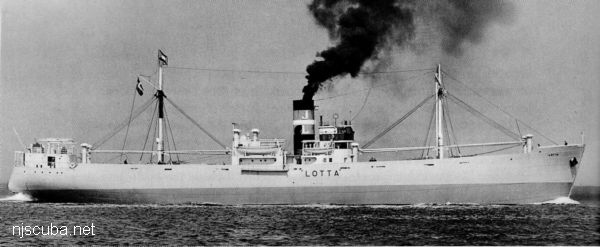
( Courtesy of J. Lauritzens. )
| Built: | 1938 |
| Previous names: | Lotta |
| Gross tonnage: | 1,858 |
| Dimensions: | 280' x 43' x 17' |
| Type of vessel: | Freighter |
| Power: | oil-fired steam turbine |
| Builder: | Aalborg Vaerft A/S, Aalborg, Denmark |
| Owner: | Chilean Government |
| Port of registry: | Valparaiso, Chile |
| Sunk: | March 13, 1942 |
| Cause of sinking: | Torpedoed by U-404 ( Kapitanteutnant von Bulow ) |
| Depth: | 90 feet |
Chile was still a nonbelligerent nation in the worldwide hostilities when the Tolten was torpedoed, on March 13, 1942. It was one of only two Latin American countries that had not severed diplomatic relations with Germany ( the other was Argentina. ) In order to maintain her neutrality according to international law, the Chilean government ordered all its ships to travel fully lighted at night so that Chilean flags could be clearly seen by enemy lookouts. This logic was based on the assumption that German U-boat commanders cared to honor the law of neutrality. All too often they did not.
While the Tolten was discharging her cargo of nitrate at Baltimore, Maryland, Captain Aquiles Ramirez received a communique from the Chilean government in which he was instructed to abide by all U.S. Navy regulations. The Navy Patrol Service in Baltimore warned him that for the last leg of his passage to New York he should maintain blackout conditions aboard his ship. That meant proceeding without showing navigation lights at night, having all portholes blanked, turning off corridor lights before opening outside doors, and not smoking on deck.
At first Captain Ramirez failed to comply. The Tolten proceeded to New York in ballast and fully lighted. Around midnight on March 12, the freighter was hailed by a patrol boat and was told in no uncertain terms to switch off her lights in accordance with previously issued instructions. This time the captain complied.
Shortly after the captain ordered the lights switched off - between two A.M. and four A.M. - a torpedo struck the Chilean freighter a devastating blow. According to the only survivor, electrician Julio Faust, the freighter went down in less than six minutes and before any lifeboats could be launched. Faust was thrown clear, swam to a loose life raft, clambered aboard, and passed out. Twelve hours later a Coast Guard patrol boat pick him up, "suffering from exposure, shock, and bruises." He was taken to the marine hospital at Stapleton, on Staten Island, where he was treated. Faust recovered from his ordeal. Nothing was ever seen of the other twenty-seven crew members.
The U.S. sent a communique to the government of Chile, informing them of the tragedy. Chile's Foreign Minister Juan Bautista Rossetti ordered an extraordinary Cabinet session to which German and Italian ambassadors and the Japanese minister were "summoned" in order to discuss the ramifications of this flagrant act of aggression. The Axis powers were losing credibility in South America.
Very quickly there occurred a repetition of the rioting that transpired in Brazil after U-boats sank several Brazilian ships. ( for that story, see Cayru in Shipwrecks of New Jersey: South, by this author. ) Shouting "Down with the Axis, " mobs protested the sinking of the Tolten by smashing the windows in the building that published the pro-Axis newspaper Chileno, and damaging other German establishments. The U.S. Acting Secretary of State played it up for all it was worth, claiming in a press conference that the Axis powers intended to sink all ships of the American Republics without distinction. His purpose was to broaden the credibility gap between South America and the governments of Germany, Italy, and Japan, and to convert neutral Latin American nations to the Allied cause. This eventually led to pro-Ally factions taking control.
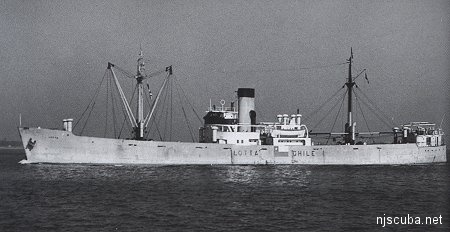
( Official U.S. Coast Guard photo. )
The Tolten also has the distinction of being the last ship lost to German U-boats that was mentioned by name in U.S. newspapers. Secretary of the Navy Frank Knox said, "The order is designed to prevent information of prime military value from reaching the enemy." thenceforth, except in rare instances, torpedoed ships would be identified only by nationality and size ( small, medium, and large ). Canada had long since adopted such a policy, refusing even to name the ports to which survivors had been taken, or from which the information originated.
The hull of the Tolten was reportedly demolished, first to a least depth of 32 feet, then to a least depth of 56 feet. Today, the wreck is a popular dive site because enough of its contiguous hull remains to be recognizable as a ship. The high sweeping stern is tilted 45 degrees to starboard and is easily accessible. A fantastic display of anemones encrusts the twenty-foot-high structure, disguising the steel, double-wheeled auxiliary helm on the fantail. The bronze propeller has been torched off and recovered, but a spare, steel propeller lies flat in the breakdown just forward of the high-rising stern section. China dinnerware has been found in the same area.
Machinery and boilers dominate the midship section, from which the hull plates have fallen outboard. A box-like structure rests on the white sandy bottom about thirty feet off the starboard side. You won't see it from the edge of the wreck if the visibility is bad or if the bottom is stirred up. This structure is the remains of the wheelhouse. It must have slid off the upper bridge deck when the wreck stood high and intact. Over the years, the hull has gradually collapsed and the plates and beams have become buried so that now the wheelhouse is separated from the main wreck.
The bow is largely intact, probably because it was strengthened for operating in ice. It lies on its starboard side and is home to some rather large lobsters that may be difficult to reach. The wreck is fun to explore because of its many niches. Lobsters and fish are abundant. Visibility is usually good to excellent.
Otto von Bulow sank the Lemuel Burrows the following day ( for details, see Shipwrecks of New Jersey: South, by this author. ) He returned to American waters several months later, and conducted another successful offensive operation against merchant shipping. Among others, he sank the steamship Manuela south of Cape Hatteras. ( for details, see Shipwrecks of North Carolina: From Hatteras Inlet South, by this author ) After that mission, von Bulow retired to land-side duty and turned over command of the U-boat to Oberleutnant zur See Schonberg. On July 28, 1943, while operating in the Bay of Biscay, combined U.S. and British air forces sank the U-404. There were no survivors.
GARY GENTILE'S POPULAR DIVE GUIDE SERIES
Shipwrecks of New Jersey: Central
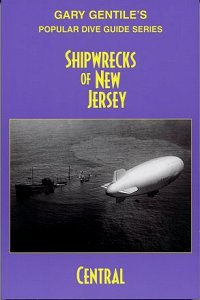
As suggested by the title and series name, this volume covers the most well-known wrecks sunk off the central geographical coast of New Jersey: from Manasquan Inlet to Egg Harbor Inlet, just north of Atlantic City.
For each of the wrecks covered, a statistical sidebar provides basic information such as the dates of construction and loss, previous names ( if any ), tonnage and dimensions, builder and owner ( at time of loss ), port of registry, type of vessel and how propelled, cause of sinking, location ( loran coordinates if known ), and depth. In most cases, a historical photograph or illustration of the ship leads the text. Throughout the book is scattered a selection of color underwater photographs, some of the wrecks, more often of typical marine life found in the area.
Each volume is full of fascinating narratives of triumph and tragedy, of heroism and disgrace, of human nature at its best and its basest. These books are not about wood and steel, but about flesh and blood, for every shipwreck saga is a human story. Ships may founder, run aground, burn, collide with other vessels, or be torpedoed by a German U-boat. In every case, however, what is emphatically important is what happened to the people who became victims of casualty: how they survived, how they died.
Also included are descriptions of the wrecks as they appear on the bottom. At the end of each volume is a bibliography of suggested reading, and a list of more than 400 loran numbers of wrecks in and adjacent to the area covered. Wrecks covered in Shipwrecks of New Jersey: Central are: A.G. Ropes/Undaunted, Akron, Ayrshire, Bidevind, Chaparra, Charlemagne Tower, Jr., Cornelius Grinnell, Cornelius Hargraves, Corvallis, Creole, Durley Chine, Fortuna, Francis Perkins, Francis Wright, Great Isaac, Guadalupe, Gulf Trade, Helen, John Minturn, Lana Carol, Lillian, Maurice Tracy, Meta, Mohawk (Clyde Liner), New York, Park City, Persephone, Remedios Pascual, R.P. Resor, San Saba, Starlight, Sumner, Texas Tower #4, Thomas Hebert, Tillie, Tolten, U-869, Vizcaya, ZPG-3W.
ISBN 1-883056-09-8, 2001 softcover with color covers, 6 x 9 vertical, 240 pages, 54 color photos, 92 black & white photos, 2 land-range drawings, 3 site plans. Over 400 loran numbers included.
To order this book and others like it, visit Gary Gentile's website at http://ggentile.com


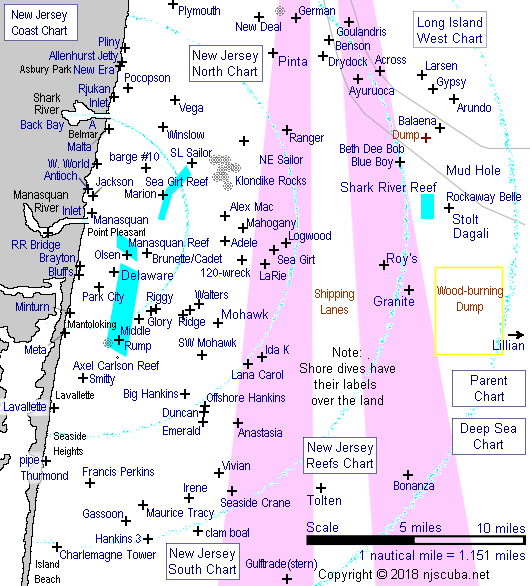
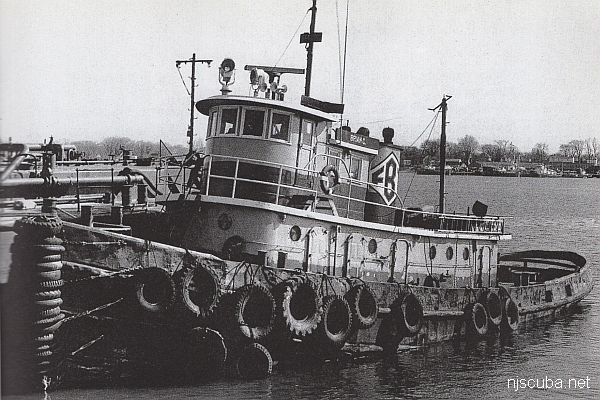
Questions or Inquiries?
Just want to say Hello? Sign the .